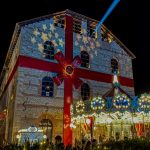Acropolis of Athens
The greatest and finest sanctuary of ancient Athens, dedicated primarily to its patron, the goddess Athena, dominates the centre of the modern city from the rocky crag known as the Acropolis. The most celebrated myths of ancient Athens, its greatest religious festivals, earliest cults and several decisive events in the city’s history are all connected to this sacred precinct. The monuments of the Acropolis stand in harmony with their natural setting. These unique masterpieces of ancient architecture combine different orders and styles of Classical art in a most innovative manner and have influenced art and culture for many centuries. The Acropolis of the fifth century BC is the most accurate reflection of the splendour, power and wealth of Athens at its greatest peak, the golden age of Perikles.
Pottery sherds of the Neolithic period (4000/3500-3000 BC) and, from near the Erechtheion, of the Early and Middle Bronze Age, show that the hill was inhabited from a very early period. A fortification wall was built around it in the thirteenth century BC and the citadel became the centre of a Mycenaean kingdom. This early fortification is partially preserved among the later monuments and its history can be traced fairly accurately. The Acropolis became a sacred precinct in the eighth century BC with the establishment of the cult of Athena Polias, whose temple stood at the northeast side of the hill. The sanctuary flourished under Peisistratos in the mid-sixth century BC, when the Panathinaia, the city’s greatest religious festival, was established and the first monumental buildings of the Acropolis erected, among them the so-called “Old temple” and the Hekatompedos, the predecessor of the Parthenon, both dedicated to Athena. The shrine of Artemis Brauronia and the first monumental propylon also date to this period. Numerous opulent votive offerings, such as marble korai and horsemen, bronze and terracotta statuettes, were dedicated to the sanctuary. Several of these bear inscriptions that show the great importance of Athena’s cult in the Archaic period. After the Athenians defeated the Persians at Marathon, in 490 BC, they began building a very large temple, the so-called Pre-Parthenon. This temple was still unfinished when the Persians invaded Attica in 480 BC, pillaged the Acropolis and set fire to its monuments. The Athenians buried the surviving sculptures and votive offerings inside natural cavities of the sacred rock, thus forming artificial terraces, and fortified the Acropolis with two new walls, the wall of Themistokles along the northern side and that of Kimon on the south. Several architectural elements of the ruined temples were incorporated in the northern wall and are still visible today.
In the mid-fifth century BC, when the Acropolis became the seat of the Athenian League and Athens was the greatest cultural centre of its time, Perikles initiated an ambitious building project which lasted the entire second half of the fifth century BC. Athenians and foreigners alike worked on this project, receiving a salary of one drachma a day. The most important buildings visible on the Acropolis today – that is, the Parthenon, the Propylaia, the Erechtheion and the temple of Athena Nike, were erected during this period under the supervision of the greatest architects, sculptors and artists of their time. The temples on the north side of the Acropolis housed primarily the earlier Athenian cults and those of the Olympian gods, while the southern part of the Acropolis was dedicated to the cult of Athena in her many qualities: as Polias (patron of the city), Parthenos, Pallas, Promachos (goddess of war), Ergane (goddess of manual labour) and Nike (Victory). After the end of the Peloponnesian war in 404 BC and until the first century BC no other important buildings were erected on the Acropolis. In 27 BC a small temple dedicated to Augustus and Rome was built east of the Parthenon. In Roman times, although other Greek sanctuaries were pillaged and damaged, the Acropolis retained its prestige and continued to attract the opulent votive offerings of the faithful. After the invasion of the Herulians in the third century AD, a new fortification wall was built, with two gates on the west side. One of these, the so-called Beul? Gate, named after the nineteenth century French archaeologist who investigated it, is preserved to this day.
In subsequent centuries the monuments of the Acropolis suffered from both natural causes and human intervention. After the establishment of Christianity and especially in the sixth century AD the temples were converted into Christian churches. The Parthenon was dedicated to Parthenos Maria (the Virgin Mary), was later re-named Panagia Athiniotissa (Virgin of Athens) and served as the city’s cathedral in the eleventh century. The Erechtheion was dedicated to the Sotiras (Saviour) or the Panagia, the temple of Athena Nike became a chapel and the Propylaia an episcopal residence. The Acropolis became the fortress of the medieval city. Under Frankish occupation (1204-1456) the Propylaia were converted into a residence for the Frankish ruler and in the Ottoman period (1456-1833) into the Turkish garrison headquarters. The Venetians under F. Morozini besieged the Acropolis in 1687 and on September 26th bombarded and destroyed the Parthenon, which then served as a munitions store. Lord Elgin caused further serious damage in 1801-1802 by looting the sculptural decoration of the Parthenon, the temple of Athena Nike and the Erechtheion. The Acropolis was handed over to the Greeks in 1822, during the Greek War of Independence, and Odysseas Androutsos became its first Greek garrison commander.
After the liberation of Greece, the monuments of the Acropolis came under the care of the newly founded Greek state. Limited investigation took place in 1835 and 1837, while in 1885-1890 the site was systematically excavated under P. Kavvadias. In the early twentieth century N. Balanos headed the first large-scale restoration project. A Committee for the Conservation of the Monuments on the Acropolis was created in 1975 with the aim to plan and undertake large-scale conservation and restoration on the Acropolis. The project, conducted by the Service of Restoration of the Monuments of the Acropolis in collaboration with the First Ephorate of Prehistoric and Classical Antiquities, is still in progress.
http://odysseus.culture.gr/
Panathenaic Stadium (Kallimarmaro)
This timeless symbol of the Greek and world sports history is inextricably linked to the revival of the Olympic Games in 1896. Panathenaic Stadium, also known as Kallimarmaro, was built by the Athenian statesman Lykourgos in 329 B.C. in order to host the Panathenaic Games (or Panathinaia), held in honor of Goddess Athena, the patron of ancient Athens.
Almost 500 years later, it was refurbished with marble by Herodes Atticus, while during 1894-1895 George Averoff, one of Greece’s major national benefactors, provided the funds for its second refurbishment, so it could host the first international Olympic Games in 1896. A multi-purpose stadium nowadays, it serves as the final Greek venue of the Olympic flame handover ceremony, as well as the finishing point of the annual Athens Classical Marathon.
Tickets General Admission: €5 Discounted Admission Tickets: €2.5 Open (March – October): 08:00-19:00 Vasileos Konstantinou Avenue (opposite the Discobolus statue), Athens Tel.: +30 210 7522984-6 www.panathenaicstadium.gr
Roman Agora of Athens
The Roman Agora was built between 19 and 11 BC with donations of Julius Caesar and Augustus, in order to become the center of financial activity in Athens during the Roman times. The selection of location was of strategic importance, since it was situated between the Sacred Rock of Acropolis and the Ancient Agora of Athens, the latter being the heart of political and commercial life of that time.
The unified architectural compound consisted of a large rectangular atrium surrounded by Ionic columns, arcades, stores and warehouses, thus reflecting Romans’ love for wealth and luxury. During the rule of the Emperor Hadrian, in the 2nd century AD, the yard was paved and expanded.
Following the Herulian invasion at the end of the 3rd century AD, the desolation of the Ancient Agora led to the transfer of the administrative and commercial center of the city to the Roman Agora and Hadrian’s Library. During the Byzantine period and Turkish occupation, houses, workshops, churches and a mosque were constructed at the space.
At the west entrance of the Roman Agora, the impressive Gate of Athena Archegetis with its four Doric columns and a pediment of Pentelic marble is well-preserved. Also, there is the Horologion of Kyrrhestes or Tower of Winds – an octagonal monument of the 1st century BC, where a hydraulic clock was housed. During your visit to the Roman Agora, you will also see the Fethiye Mosque, built in 1456 AD at the northern part of the Agora over the ruins of an early Christian church, as well as the Vespasians, the public restrooms of the 1st century AD.
The Roman Agora starts at the conjunction of Aiolou and Pelopida streets, in Plaka.
Τel.: +30 210 3245220
Temple of Poseidon at Cape Sounion
As the sun goes down, you find yourself marveling at the works of nature and man on the southernmost tip of Attica, in a sacred and spiritual place, where land and sea merge. Only 43 miles away from the center of the Athens, Cape Sounion (also known as Cavo Kolones), lies on a steep cliff. This is where it is fabled that Aegeus, a mythic King of Athens, anxiously awaited the return of his son Theseus and decided to leap to his death, thus giving his name to the Aegean Sea. The sunset-tinted Saronic Gulf spreads out before you while the remains of the Doric Temple of Poseidon, one of the greatest monuments of the ancient Greece, stand right behind you in their entire splendor. This place of worship of the god of the sea was built during the Age of Pericles (circa 444-440 B.C.) on the ruins of an earlier archaic temple, on the highest spot of the cape, offering a breathtaking panoramic view.
Lord Byron’s name, neatly inscribed at the base of one of the temple’s marble columns, makes you recall one of the philhellene poet’s most famous verses: Place me on Sunium’s marbled steep / Where nothing save the waves and I / May hear our mutual murmurs sweep / There, swan-like, let me sing and die.
Deeply immersed in the awe-inspiring landscape and its echoing glory, you cannot help but think that this is a land made for Gods.
Tickets General Admission: €8 Discounted Admission: €4
Open: 09:00- dusk Tel.: +30 22920 39363











